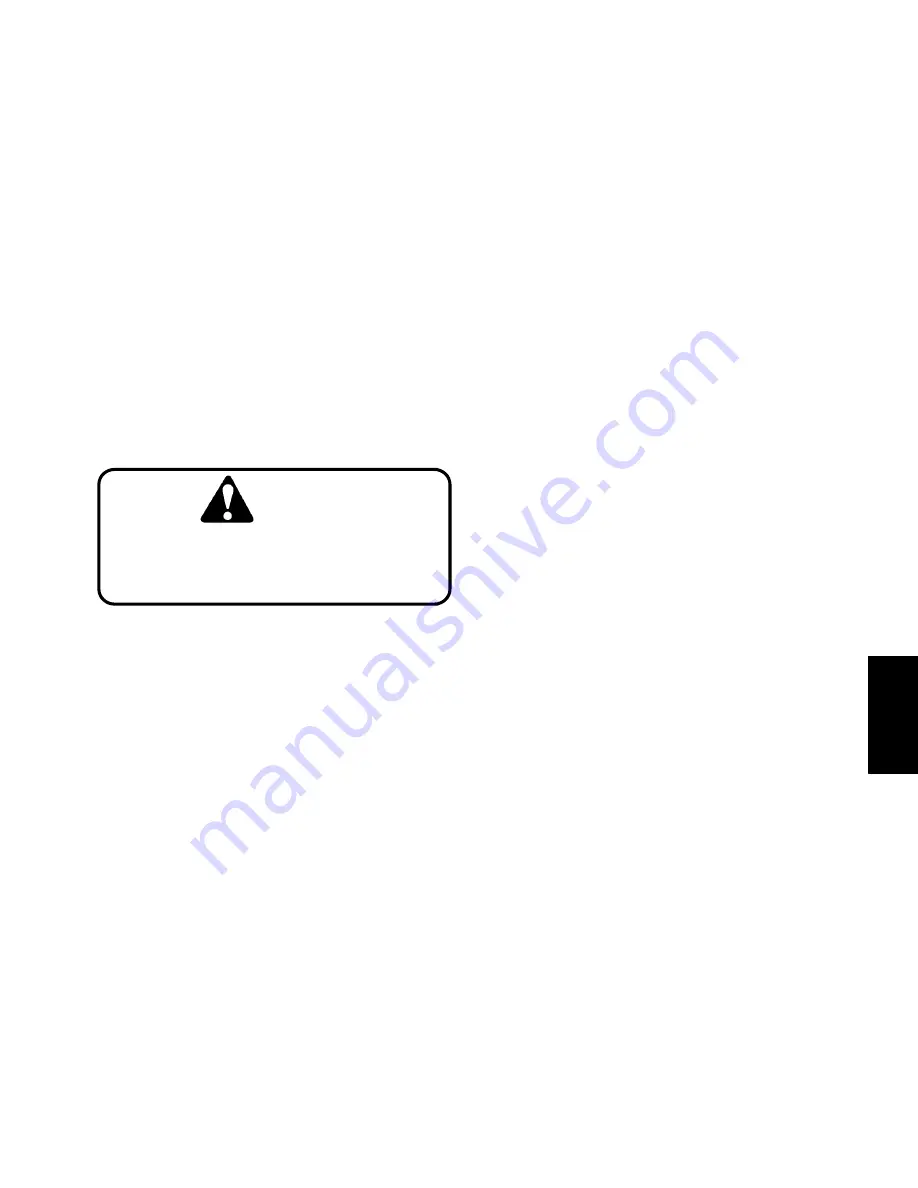
4. Gain access to front ball joint.
A. Remove three cap screws and flat washers se-
curing the fuel tank base plate to frame. Two screws
are on the top of the plate at the front corners of the
tank. The third screw is in front of the castor fork and
below the plate.
B. Tilt fuel tank base up by lifting at the right of the
machine to gain access to the top of the jam nuts
and ball joint. Prop up tank securely.
5. Remove both jam nuts from the ball joint. Rotate
steering cylinder and detach ball joint from frame brack-
et.
6. Pivot steering cylinder out from the frame. Remove
retaining ring from the rear of the cylinder. Remove cyl-
inder from rear ball joint.
7. Remove front retaining ring and ball joint from the
steering cylinder. Remove hydraulic fittings and O–rings
from the cylinder.
CAUTION
Support rear wheel to prevent dropping
them and causing personal injury while re-
moving hex nut. Use two people to remove
steering cylinder.
8. If the rear ball joint needs to be removed, accom-
plish the following:
A. Block front wheels. Jack up rear wheel off the
ground by the frame. Secure the frame with the
wheel off the ground.
B. Remove lock nut, bolt, spacers, and wheel from
the castor fork.
C. Remove jam nuts and ball joint from the castor
fork.
Installation (Fig. 84)
1. f the rear ball joint was removed, accomplish the fol-
lowing:
A. Secure ball joint to the castor fork with jam nuts.
Torque nuts from 65 to 85 ft–lb (9.0 to 11.8 kg–m).
B. Install wheel to the castor fork by inserting the
bolt through the fork, spacer, wheel, spacer, and
fork. Secure bolt with lock nut.
C. Lower wheel to ground
2. Install hydraulic fittings and O–rings to the steering
cylinder. Install front ball joint to the cylinder and secure
with retaining ring.
3. Install steering cylinder to the rear ball joint. and se-
cure with retaining ring.
4. Pivot steering cylinder into the frame. Rotate steer-
ing cylinder and install ball joint to the frame bracket. Se-
cure ball joint to the bracket with jam nuts. Torque nuts
from 65 to 85 ft–lb (9.0 to 11.8 kg–m).
5. Lower fuel tank base to the frame. Secure base to
the frame with the three cap screws and flat washers.
6. Remove caps or plugs from the disconnected hose
and fittings. Connect hose assemblies and O–rings to
the hydraulic fittings. Tighten hose connections.
Hydraulic
System
Greensmaster 3200/3200–D
Page 5 – 97
Hydraulic System
Summary of Contents for 3200
Page 2: ...Greensmaster 3200 3200 D ...
Page 4: ...Greensmaster 3200 3200 D ...
Page 6: ...Greensmaster 3200 3200 D ...
Page 12: ...Safety Page 1 6 Greensmaster 3200 3200 D ...
Page 14: ...Equivalents and Conversions Product Records and Maintenance Page 2 2 Greensmaster 3200 3200 D ...
Page 17: ...Product Records and Maintenance Page 2 6 Greensmaster 3200 3200 D ...
Page 72: ...Perkins Diesel Engine Page 4 30 Greensmaster 3200 D ...
Page 113: ...Hydraulic System Greensmaster 3200 3200 D Page 5 41 Hydraulic System ...
Page 161: ...Hydraulic System Greensmaster 3200 3200 D Page 5 89 Hydraulic System ...
Page 173: ...Hydraulic System Greensmaster 3200 3200 D Page 5 101 Hydraulic System ...
Page 234: ...Wheels and Brakes Page 7 12 Greensmaster 3200 3200 D ...
Page 261: ...Cutting Units Greensmaster 3200 3200 D Page 8 27 Cutting Units ...
Page 273: ......
Page 274: ...Commercial Products FORM 96 900 SL E The Toro Company 1997 Printed in U S A ...
















































